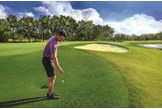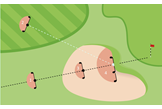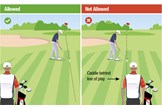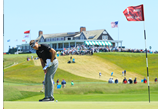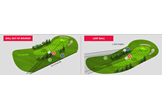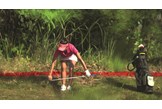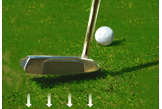2019 Rules of Golf: Your guide to the new rules
Published: Last updated:
The new rules of golf officially came in to effect on January 1st, but were you ready for them? We’ve packed everything you need to know, including the biggest rule changes, in to this simple guide…
Faster, simpler and fairer. That’s the idea behind the rules modernisation, which is nearly seven years in the making and is the most comprehensive revision since 1952. From January 1, 2019, every golfer will need to conform to 24 rules, which are now more practical and accessible for newcomers.
The wording is also much easier to understand and make sense of, and there’s even a Player’s Edition book, especially for club golfers, which features diagrams and “purpose statements” to clarify and explain the fundamentals out on the course. The digital generation are also catered for with a Rules of Golf 2019 app, while traditionalists can pore over the Official Guide to the Rules of Golf and their interpretations.
To help you prepare for your first medal round of the New Year, we’ve produced our own guide and broken down the biggest – and most useful – rule changes that you need to know…
Searching for your ball
Your search time has been cut from five to three minutes
Start the clock. You’ve only got 180 seconds to find a lost ball. And if you or your playing partners do move it while trying to find or identify it, the ball must be replaced to its original spot (which if not known must be estimated) without penalty.
When searching, you no longer have to announce your intention to mark and lift your ball to another person.
Playing A Ball
You may take free relief for an embedded ball anywhere in the general area (except in sand)
When taking a free or penalty relief, you are allowed to substitute a ball or use the original ball. The choice is yours.
Note: General area is the new term for “through the green”.
Drops must be taken from knee height, not shoulder height
When taking relief, the ball must be dropped in and come to rest in the relief area. If it does not, you must drop once more before being allowed to place it.

Taking your stance on the wrong green is not permitted
Yes, it’s embarrassing enough if you’ve found your ball on or near the wrong green. But if there’s any interference with the green when taking your stance, you must take free relief by dropping the ball.
Size of relief area
The relief area for dropping a ball will be a fixed size of either one or two clublengths, depending on which relief rule is being used.
Bunkers
There’s an extra relief option
More good news for those who struggle from the sand. If you decide that your ball is unplayable, you can now take “back on line” relief outside the bunker (1). It will cost you two penalty strokes, but you might end up saving shots.
➤ For one penalty stroke, you may take: stroke-and-distance relief (2); ‘back on line’ relief inside the bunker (3); or lateral relief inside the bunker (4).

You can now move loose impediments (including stones) anywhere on the course
The “relaxed rules” also mean there’s no penalty for touching the ground or water in a penalty area. In the bunker, you’re still penalised for testing the condition and/or grounding the club next to the ball, but incidentally touching the sand with your club is OK.
Penalty Areas
Penalty areas supersede water hazards
The expanded concept will not only include lakes, ponds and streams, but also the likes of deserts and jungles. Yellow and red markers will still be used, but Committees may mark more areas as red to allow players to take lateral relief.
Elimination of opposite side relief in a red penalty area
The old option of dropping under penalty, on the opposite side of the water hazard to where your ball last crossed the edge of the hazard, has been removed.

Equipment
Distance measuring devices are now permitted
Unless a Local Rule says otherwise; check with the club.
You’re allowed to continue using a damaged club during a round
Good news for the Tyrrell Hattons of this world! If you do take your anger out on a driver and break it, you can still use it. However, you may only replace a damaged club during a round if you or your caddie were not responsible.
Pace of Play
Ready golf is encouraged
Stopwatches at the ready. It’s recommended that no stroke should take longer than 40 seconds. There’s also a new “Maximum Score” form of strokeplay, where a player’s score for a hole is capped at a maximum (such as two times par or triple bogey) and set by the Committee.
On The Green
You can putt with the flagstick in
Don’t waste time taking the flag out and putting it back in. There’s no penalty if a putt hits an unattended flagstick. If a ball is wedged against the flagstick and part of the ball is below the surface of the green, it is treated as holed.

Spike marks can be repaired without penalty
There’s now no excuse for making a poor putt. Every golfer can don the role of greenkeeper without penalty and repair damage to the putting green. This includes:
➤ Ball marks, scrapes or indentations caused by equipment or a flagstick.
➤ Old hole plugs, turf plugs, seams of cut turf and scrapes or indentations from maintenance tools or vehicles.
➤ Animal tracks or hoof indentations, and embedded objects (such as a stone, acorn or tee).

No more penalties if your ball or ball marker is moved accidentally by you or your opponent
The same applies if the ball moved, due to wind or other natural forces, after being marked. Just replace it on that spot and hurry up before it moves again!
Merely touching the line of play is allowed
Admit it, you probably did it anyway – and got away with it. But now you will be adhering to the rules, as long as you do not improve the condition of the line (see 8.1a).
Caddies
Caddies can mark and lift a player’s ball on the putting green at any time without needing authorisation
Making A Stroke
If your ball accidentally strikes you, your opponent or your equipment, carry on without penalty
So, if you do skull one into the face of the bunker and the ball hits you, play it from where it came to rest and try to ignore the heckling.
Caddie assistance with alignment is no longer allowed
Positioning a club for alignment is also outlawed. Some LPGA Tour players are distraught…
Double hits count as one stroke
They’re embarrassing enough, aren’t they? Thankfully, they no longer cost you two shots.
Local OB Rules
An alternative to stroke and distance for losing a ball or going out of bounds
Take note: CONGU will prohibit the use of this Local Rule for the purpose of any round counting towards handicap. However, for non-competitive rounds, Committees may give you the option of dropping the ball, under the penalty of two strokes, in a large area as shown in the diagram
A. Determine the spot where your ball went out of bounds or is likely to be lost.
B. Find the nearest fairway edge, no closer to the hole.
C. Drop your ball in the shaded area. The relief area is extended on both sides by two club-lengths

New Limits On Green Books
This one mainly applies to Tour pros
Golfers may continue to use a putting-green map or other putting-green information, but changes include limiting the size and scale of detailed green maps (now commonplace on Tour) and any similar electronic or digital material that a player may use during a round to assist with reading their putting line.
➤ Any image of a putting green must be limited to a scale of 3/8 inch to 5 yards (1:480) or smaller (the “scale limit”).
➤ Any book or other paper containing a map or image of a putting green must not be larger than 4 ¼ inches x 7 inches (the “size limit”), though a “hole location sheet” that displays nine or more holes on a single sheet of paper may be larger, provided that any image of a single putting green meets the scale limit.
➤ No magnification of putting-green information is allowed other than a player’s normal wearing of prescription glasses or lenses.
➤ Hand-drawn or written information about a putting green is only allowed if contained in a book or paper meeting the size limit and written by the player and/or his or her caddie.
The final interpretation also clearly defines that any use of electronic or digital putting-green maps must comply with the same limits. A player is still in breach of Rule 4.3 if the player uses any device not consistent with the purpose of the limits, including:
➤ Increasing the size of the green’s representation beyond the scale or size limits.
➤ Producing a recommended line of play based on the location (or estimated location) of the player’s ball.


